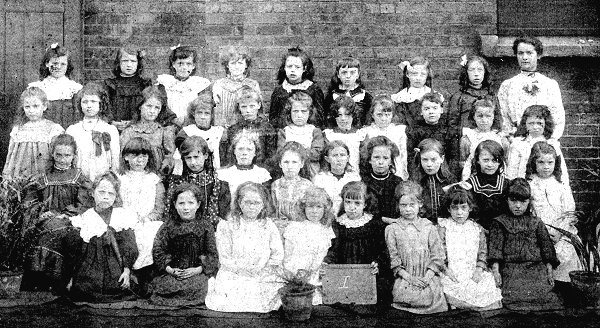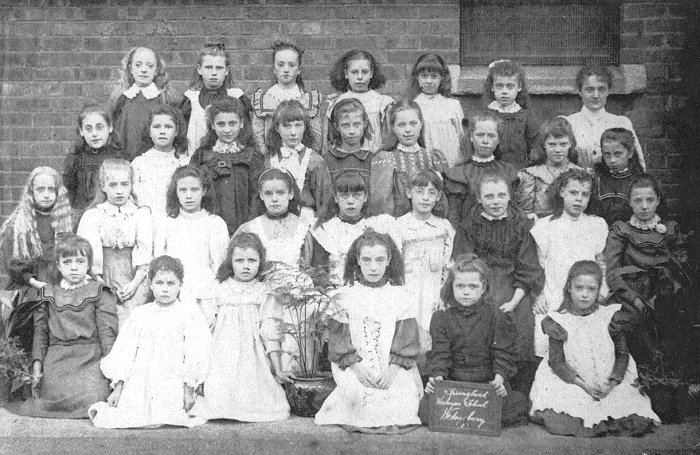| The Board schools had the advantage of better
tuition under qualified instructors, and taught a
wider range of subjects including cookery, and
woodwork. From 1889 until 1890 Wednesbury also had
a Higher Grade School which offered a wider range of
subjects including chemistry, foreign languages, and
mechanics. The school could accommodate 120 pupils
who each paid a fee of 1 shilling a week for their
tuition and books. The school got off to a good
start with 90 children attending, but the number
soon fell to 48 and the school closed. The decline
in numbers was mainly due to the opening of the
Municipal Technical College in 1892, built as a
result of the Technical Instruction Act of 1889.
The School Boards were abolished as a result of the
terms of the1902 Education Act which gave local
councils the task of appointing an education
committee to oversee education in their area.
Wednesbury's Education Committee carefully
controlled their expenditure, often to the detriment
of the children and schools. From November 1905
children younger than 5 years of age were not
allowed to attend school and the committee limited
the amount of money spent on each child for books,
apparatus, and stationary to just 3 shillings a
year. Things got so bad that teachers ended up
paying for materials themselves. In 1908 during an
inspection, 5 of the voluntary school premises were
found to be unsatisfactory and as a result 3 of them
closed in 1912 when the Council School was built in
Holyhead Road. They were the Wesleyan Schools at
Spring Head and Holyhead Road, and the Church School
at Moxley.
The next great change took place as a result of the
Hadow Reports of 1926 and 1930 which recommended that
elementary schools should be divided into primary
schools for the under 11s and senior schools for the
older children. This reulted in the building of several
new schools:
| Moxley Primary
School in 1927 |
| Hobs Road Primary
School in 1931 |
| Old Park Road
Senior School, King's Hill (accommodation
800) |
| Holyhead Road
Senior School (accommodation 1,460) |
Mesty Croft School was extended in 1931 and a
number of other schools were built in the following
years:
| Woodland Grange
School in 1923 |
| St. Mary's Convent
School, Church Hill opened in 1930, closed
in the summer of 1965. |
| Walton Road School
in 1939 |
| St. Mary's Primary
School in 1940 |
As a result of the Education Act of 1944 the control
of the town's education was passed onto the County
Council in 1945. Wednesbury
Boys High School The school opened in
September, 1924 in the residence of the late Sir
Albert Pritchard, one time Chairman of the
Governors. There were initially 50 boys, but the
number soon increased to 100. In the autumn of 1926
the first of 3 major extensions were added,
consisting of an assembly hall, 2 science
laboratories, and 2 additional classrooms. In 1932,
two more classrooms, an art room, a library,
cloakrooms and a wash lobby were added. In the
autumn of 1960 further extensive alterations and
additions were carried out, consisting of a new
science block of 4 laboratories, a dining room and
kitchen, extensions to the hall, conversion of the
existing science rooms into a woodwork room, and an
art-and-craft room, new cloakrooms, changing rooms,
and adequate washing facilities, with showers. The
old Pritchard house was demolished and replaced with
a new administrative block, a greatly enlarged
library, 2 new classrooms and a division room. After
which there were 10 classrooms and a total of 19
teaching rooms including the specialised areas. In
1958 the school was equipped with a fine modern
stage with excellent lighting equipment, and
alterations were made to the assembly hall so that
it could also serve as a gymnasium. The school
caretaker was re-housed at a corner of the school
playing fields which at the time covered around 4 to
5 acres. Tennis courts were also added to the
playground. By the early 1960s the number of
children on the roll had reached 362.
Wednesbury Girls High School
The school opened in Hydes Road in
September 1958 to provide grammar school education for
about 350 girls aged 11-18. The buildings were designed
to include a very good library, 3 laboratories and
preparation rooms, an art room, a domestic science room,
a magnificent gymnasium, specialist rooms for geography
and music, and a very well equipped kitchen and dining
room. The grounds were drained and laid out to provide
extensive playing fields.
|

This lovely photo
belongs to Charles Hippisley-Cox. His
grandmother, Anne Lavender, who lived in
Union Street, is the girl second from
the left, in the back but one row, with
curls in her hair, and a large dark bow
on her dress. The photo was taken at
Spring Head Wesleyan School. The
schoolmaster was Mr. J. C. Gaskell, and
the schoolmistress was Miss May Gaskell. |
|

Another class at
Spring Head Wesleyan School. Courtesy of
Chris Rapley. |
| This is the
shoe shop in Union Street where Ann
Lavender (who is in the photograph
above) was born. Her mother Emma ran the
shop, which was owned by Anne's uncle
Jabez Stevens.
The boys in the
photograph are Alf and Tom Lavender,
brothers of Jack Lavender
who founded J. H. Lavender at Stone
Cross, the aluminium casting firm, which
is still there today.
The shop still
survives, and is now a chip shop.
Courtesy of
Charles Hippisley-Cox.
|
 |
|